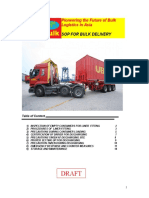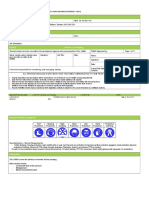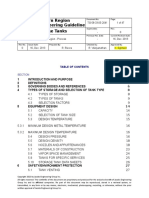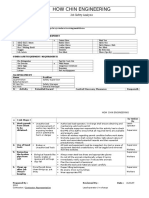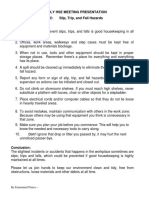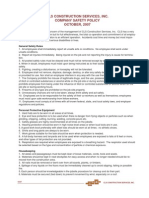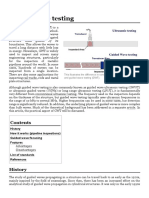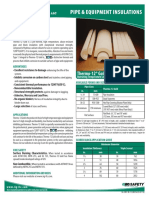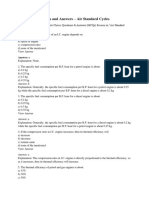Fall Protection Definitions
Fall Protection Definitions
Uploaded by
alphadingCopyright:
Available Formats
Fall Protection Definitions
Fall Protection Definitions
Uploaded by
alphadingCopyright
Available Formats
Share this document
Did you find this document useful?
Is this content inappropriate?
Copyright:
Available Formats
Fall Protection Definitions
Fall Protection Definitions
Uploaded by
alphadingCopyright:
Available Formats
FALL PROTECTION DEFINITIONS
Fall Hazard Risk Consultants
Term Definition
Aerial lift device Equipment such as powered platforms, vehicle-mounted elevated and
rotating work platforms, extensible boom platforms, aerial ladders,
articulating boom platforms, vertical towers and powered industrial truck
platforms
Anchorage An engineered and designed point of attachment for lifelines, lanyards or
deceleration devices
Body harness Straps which may be secured about the employee in a manner that will
distribute the fall arrest forces over at least the thighs, pelvis, waist, chest
and shoulders with means for attaching it to other components of a personal
fall arrest system
Confined space (1) Is large enough and so configured that an employee can bodily enter and
perform assigned work; and
(2) Has limited or restricted means for entry or exit (for example, tanks,
vessels, silos, storage bins, hoppers, vaults, and pits are spaces that may
have limited means of entry.); and
(3) Is not designed for continuous employee occupancy
Connector A device, which is used to couple (connect) parts of the personal fall arrest
system and positioning device systems together. It may be an independent
component of the system, such as a carabiner, or it may be an integral
component of part of the system (such as a buckle or d-ring sewn into a
body belt or body harness, or a snap-hook spliced or sewn to a lanyard or
self-retracting lanyard,)
Controlled access A work area designated and clearly marked in which certain types of work
zone may take place without the use of conventional fall protection systems
(guardrail, personal arrest, or safety net) to protect the employees working
in the zone.
Deceleration device Any mechanism, such as a rope, grabbing device, ripstitch lanyard,
specially woven lanyard or automatic self-retracting lifeline/lanyard, which
serves to dissipate a substantial amount of energy during a fall arrest, or
otherwise limits the energy imposed on an employee during fall arrest
www.reichleassoc.com Ph: 610.793.0137 sales@reichleassoc.com
Copyright 2012, Bill Reichle Associates, LLC. All Rights Reserved
Term Definition
Deceleration The additional vertical distance a falling employee travels, excluding lifeline
distance elongation and free fall distance, before stopping, from the point at which
the deceleration device begins to operate.
It is measured as the distance between the location of an employee's body
belt or body harness attachment point at the moment of activation (at the
onset of fall arrest forces) of the deceleration device during a fall, and the
location of that attachment point after the employee comes to a full stop
Fall hazard The act or circumstances that could result in the possibility of slipping or
tripping on or falling off a surface.
Fall restraint system A fall protection system that prevents the user from falling any distance.
The system is comprised of either a body belt or body harness, along with
an anchorage, connectors and other necessary equipment. The other
components typically include a lanyard, and may also include a lifeline and
other devices.
Fixed ladder A ladder, including individual rung ladders, which are permanently
attached to a structure, building, or equipment.
Free fall distance The vertical displacement of the fall arrest attachment point on the
employee's body belt or body harness between onset of the fall and just
before the system begins to apply force to arrest the fall.
This distance excludes deceleration distance, and lifeline/lanyard
elongation, but includes any deceleration device slide distance or self
retracting lifeline/lanyard extension before they operate and fall arrest
forces occur
Guardrail system A 42 barrier erected to prevent employees from falling to lower levels
Hole A void or gap 2 inches or more in its least dimension in a floor, roof, or
other walking/working surface
Horizontal lifeline A flexible line between two horizontal fixed anchorages to which a fall
arrest device is connected
Infeasible Impossible to perform the work using a conventional fall protection system
(i.e., guardrail system, safety net system, or personal fall arrest system) or
that it is technologically impossible to use any one of these systems to
provide fall protection
Ladder A device typically used to gain access to a different elevation consisting of
two or more structural members crossed by rungs, steps, or cleats
www.reichleassoc.com Ph: 610.793.0137 sales@reichleassoc.com
Copyright 2012, Bill Reichle Associates, LLC. All Rights Reserved
Term Definition
Lanyard A flexible line of rope, wire rope, or strap that has a connector at each end
for connecting the body harness and to an anchorage point.
Leading edge The edge of a floor, roof, or formwork for a floor or other walking/working
surface (such as a deck) which changes location as additional floor, roof,
decking, or formwork sections are placed, formed, or constructed.
Lifeline A component consisting of a flexible line for connection to an anchorage at
one end to hang vertically (vertical lifeline), or for connection to anchorages
at both ends to stretch horizontally (horizontal lifeline), that serves as a
means for connecting other components of a personal fall arrest system to
an anchorage.
Lower levels Those areas or surfaces to which and employee can fall. Such areas include,
but are not limited to, ground levels, floors, platforms, ramps, runways,
excavations, pits tanks, material, water, equipment, structures
Low-sloped roof A roof having a slope less than or equal to 4 in 12 (vertical to horizontal).
Maximum Arrest Maximum dynamic loads applied to fall protection system and anchorage
Force (MAF) points
Maximum Intended The total load of all employee, equipment, tool, materials, transmitted,
Load wind, and other loads reasonably anticipated to be applied to a scaffold or
scaffold component at any one time
Opening A gap or void 30 inches (76 centimeters) or more high and 18 inches (46
centimeters) or more wide, in a wall or partition through which employees
can fall to a lower level.
Parapet A parapet surrounding the edge of a roof at least 42 inches for all general
industry work
Permit-required A confined space that has one or more of the following characteristics:
confined space
(1) Contains or has a potential to contain a hazardous atmosphere;
(2) Contains a material that has the potential for engulfing an entrant;
(3) Has an internal configuration such that an entrant could be trapped or
asphyxiated by inwardly converging walls or by a floor which slopes
downward and tapers to a smaller cross-section; or
(4) Contains any other recognized serious safety or health hazard.
www.reichleassoc.com Ph: 610.793.0137 sales@reichleassoc.com
Copyright 2012, Bill Reichle Associates, LLC. All Rights Reserved
Term Definition
Personal fall arrest A system used to arrest an employee in a fall from a working level.
system (PFAS) It consists of an anchorage, connectors, full body harness and may include a
lanyard, deceleration device, lifeline, or suitable combinations of these.
As of January 1, 1998, the use of a body belt for fall arrest is prohibited
Personal Protective Protective equipment designed for the eyes, face, ears and body extremities
Equipment (PPE)
Rescue plan Strategy or procedure, planned in advance and practiced by designated
rescue personnel, to retrieve safely a person who has fallen from an elevated
work surface and who remains suspended in a full body harness, unable to
perform self-rescue
Retrieval system Equipment (including a retrieval line, chest or full-body harness, wristlets, if
appropriate, and a lifting device or anchor) used for non-entry rescue of
persons from permit spaces
Rope grab A deceleration device that travels on a lifeline and automatically, by friction,
engages the lifeline and locks so as to arrest the fall of an employee.
A rope grab usually employs the principle of inertial locking, cam/level
locking, or both
Safety monitoring A safety system in which a competent person is responsible for recognizing
system and warning employees of fall hazards.
Scaffold Any temporary elevated or suspended platform, at its supporting
structures, used for supporting employees or materials or both
Self-retracting A deceleration device containing a drum-wound line which can be slowly
lifeline (SRL) extracted from, or retracted onto, the drum under slight tension during
normal employee movement, and which, after onset of a fall, automatically
locks the drum and arrests the fall
Snaphook A connector consisting of a hook-shaped member with a normally closed
keeper, or similar arrangement, which may be opened to permit the hook to
receive an object and, when released automatically closes to retain the
object. Only locking snap hooks are permitted.
Steep roof A roof having a slope greater than 4 in 12 (vertical to horizontal).
Swing fall A condition that exists when a workers anchorage point is not directly
above the worker when he falls, causing his body to act like a pendulum,
and greatly increasing the likelihood of him striking an object, scaffold or
building when falling
www.reichleassoc.com Ph: 610.793.0137 sales@reichleassoc.com
Copyright 2012, Bill Reichle Associates, LLC. All Rights Reserved
Term Definition
Tie-off adapter Provides temporary anchorage point for fall protection system
Toe board A low protective barrier that prevents material and equipment from falling
to lower levels and which protects personnel from falling
Total Fall Distance This distance includes free fall distance + deceleration distance + harness d-
ring slide + height of individual + safety factor
Any side or edge (except at entrances to points of access) of a
Unprotected sides
and edges walking/working surface (e.g., floor, roof, ramp, or runway) where
there is no wall or guardrail system at least 39 inches (1 meter) high
Vertical lifeline A component consisting of a flexible line for connection to an anchor point
at one end to hang vertically and that serves as a means for connecting other
components of a personal fall arrest system to the anchor point
Walking/working Any surface, whether horizontal or vertical, on which an employee walks or
surface works, including but not limited to floors, roofs, ramps, bridges, runways,
formwork, and concrete reinforcing steel. Does not include ladders,
vehicles, or trailers on which employees must be located to perform their
work duties.
Warning line A barrier erected on a roof to warn employees that they are approaching an
system unprotected roof side or edge and which designates an area in which
roofing work may take place without the use of guardrail, body belt, or
safety net systems to protect employees in the area
Work area Portion of a walking/working surface where job duties are being
performed
100% protection Remaining connected to one anchor point while connecting to the next
anchor point; i.e., not disconnecting from one point before connecting to the
next.
www.reichleassoc.com Ph: 610.793.0137 sales@reichleassoc.com
Copyright 2012, Bill Reichle Associates, LLC. All Rights Reserved
You might also like
- PMI Report TemplateDocument2 pagesPMI Report TemplateKewell LimNo ratings yet
- Engine Control: 2002 RAV4 (EWD466U)Document10 pagesEngine Control: 2002 RAV4 (EWD466U)Jorge Negretti100% (3)
- Corrosion AllowanceDocument9 pagesCorrosion AllowancealphadingNo ratings yet
- Contract Risk Assessment DeliveryDocument8 pagesContract Risk Assessment DeliverySagar Bhavsar100% (1)
- Fire Prevention PlanDocument1 pageFire Prevention PlanAlfred Harvey Elacion0% (1)
- SWMS 2 Fixing CarpenterDocument3 pagesSWMS 2 Fixing CarpenterJonasNo ratings yet
- Checklist WeldingDocument5 pagesChecklist WeldingMarko RisticNo ratings yet
- Dry Bulk Product Safety SOPDocument14 pagesDry Bulk Product Safety SOPWan Sek Choon100% (1)
- JSA FOR Fall ProtectionDocument2 pagesJSA FOR Fall Protectionwahyu nugroho100% (6)
- Safe Work Method StatementDocument11 pagesSafe Work Method StatementJNo ratings yet
- Preliminary Steel Composite Bridge Design ExampleDocument11 pagesPreliminary Steel Composite Bridge Design Examplemamad66No ratings yet
- RS 1500 Sulphur GranulatorDocument4 pagesRS 1500 Sulphur GranulatorvzgscribdNo ratings yet
- Bird Netting Instructions GuideDocument7 pagesBird Netting Instructions GuideBird-XNo ratings yet
- Motor Failure Report PDFDocument13 pagesMotor Failure Report PDFpranav0567% (3)
- BOMBA DE ALTA PRESION DENSO HP0pdf PDFDocument4 pagesBOMBA DE ALTA PRESION DENSO HP0pdf PDFVictor GarciaNo ratings yet
- Storage Tank GuidelineDocument47 pagesStorage Tank GuidelineAnonymous 7PaXIM93% (27)
- Personal Fall Protection 1Document12 pagesPersonal Fall Protection 1Alyssa GarciaNo ratings yet
- Fall Protection PolicyDocument17 pagesFall Protection PolicymuhammadkashikNo ratings yet
- Slips FallsDocument51 pagesSlips FallsSham AranNo ratings yet
- SampleAHA - Core Drilling - SawCutting - Concrete - Asphalt - Wet MethodDocument1 pageSampleAHA - Core Drilling - SawCutting - Concrete - Asphalt - Wet MethodJaycee Bareng PagadorNo ratings yet
- WBHO Sub Contractor Safety File RequirmentsDocument6 pagesWBHO Sub Contractor Safety File RequirmentsNana Opoku-Amankwah100% (3)
- 2 33 Working at Heights ProcedureDocument7 pages2 33 Working at Heights ProcedureRoni EnjelaniNo ratings yet
- Proper and Safe Use of Scissor LiftsDocument3 pagesProper and Safe Use of Scissor LiftsJulius SablayanNo ratings yet
- Fall Protection Plan FormDocument5 pagesFall Protection Plan Formharpreetresearch100% (1)
- Security DeliverablesDocument3 pagesSecurity Deliverablesjohnny59471503No ratings yet
- Security Risk AssessmentDocument8 pagesSecurity Risk AssessmentroonephyNo ratings yet
- Jsa PolypipeDocument2 pagesJsa PolypipeHow Chin Engineering Sdn BhdNo ratings yet
- Confined Spaces CardsDocument1 pageConfined Spaces CardsJafar KhanNo ratings yet
- Fall Prevention Plan: (Only Applicable To Contractor That Have Work Activities More Than 03 Meters and Above.)Document21 pagesFall Prevention Plan: (Only Applicable To Contractor That Have Work Activities More Than 03 Meters and Above.)Md ShahinNo ratings yet
- 1926 Fall Protection ProgramDocument25 pages1926 Fall Protection ProgramDaDemonNo ratings yet
- Hse Meeting PresentationDocument1 pageHse Meeting PresentationEmmanuelNo ratings yet
- Construction Job Safety Analysis - Safety Science Y2010Document10 pagesConstruction Job Safety Analysis - Safety Science Y2010Yongsak Yungyuen100% (2)
- JSA Termite SprayingDocument3 pagesJSA Termite SprayingkehamchoiNo ratings yet
- Scaffolds Scaffolding Work General GuideDocument18 pagesScaffolds Scaffolding Work General GuideSanjoy ChowdhuryNo ratings yet
- Tk5c - Ppe Toolbox TalkDocument2 pagesTk5c - Ppe Toolbox TalksjmpakNo ratings yet
- Safe Work Method Statement WorksheetDocument7 pagesSafe Work Method Statement WorksheetianllagasNo ratings yet
- Workplace Hazards in ConstructionDocument2 pagesWorkplace Hazards in ConstructionDWi Uwee DejHeNo ratings yet
- Project: Field Erection of 15000 Bbls Tank (Ik-2545) : Job Safety AnalysisDocument4 pagesProject: Field Erection of 15000 Bbls Tank (Ik-2545) : Job Safety AnalysisJohn100% (1)
- JSA For Pressure Test 2ND REVISIONDocument10 pagesJSA For Pressure Test 2ND REVISIONMuthu AlaguRaj100% (1)
- Safety Policy 2007-10Document2 pagesSafety Policy 2007-10Bob SilvaNo ratings yet
- Chisels Risk AssessmentDocument1 pageChisels Risk AssessmentTawfik Mohamed Abu Zaid100% (1)
- Dust & FumeDocument29 pagesDust & FumeAfzaalUmair100% (1)
- Hazards While Loading and Unloading Truck TrailersDocument1 pageHazards While Loading and Unloading Truck Trailersravichandran0506No ratings yet
- Fall Protection Plan (Feb 2023)Document3 pagesFall Protection Plan (Feb 2023)Keong Chee TongNo ratings yet
- A B C D: Risk & Environmental Assessment For: Lifting Operations With Overhead CranesDocument11 pagesA B C D: Risk & Environmental Assessment For: Lifting Operations With Overhead CranesMohammed Ali QaziNo ratings yet
- PTW - Confined Space - ENDocument1 pagePTW - Confined Space - ENATSI HadjilaNo ratings yet
- JSA ScaffoldingDocument2 pagesJSA ScaffoldingHrishikesh Unnikrishnan100% (1)
- Fall Protection Risk AssessmentDocument3 pagesFall Protection Risk AssessmentsimoneNo ratings yet
- Toolbox Talks Office SafetyDocument1 pageToolbox Talks Office Safetyfandhy AnwarNo ratings yet
- 25 - HSE-Confind Space EntryDocument9 pages25 - HSE-Confind Space EntryP Eng Suraj SinghNo ratings yet
- Scaffolds (Erector User)Document1 pageScaffolds (Erector User)Iddin NaguibNo ratings yet
- Construction Job Safety/Hazard Analysis Job #: Location/Description: OwnerDocument33 pagesConstruction Job Safety/Hazard Analysis Job #: Location/Description: OwnerHortencio SamuelNo ratings yet
- Job Hazard Analysis PDFDocument8 pagesJob Hazard Analysis PDFashok Kumar100% (1)
- RA For Erection of Precast Elemenets For BOP Ref. No 3761800008-R-01-C-E-69047 - ADocument33 pagesRA For Erection of Precast Elemenets For BOP Ref. No 3761800008-R-01-C-E-69047 - ARAMY ABOU AL DAHABNo ratings yet
- Plastering Jha With Work at HeightDocument4 pagesPlastering Jha With Work at HeightJayson ArellanoNo ratings yet
- Fall Protection HandoutDocument1 pageFall Protection HandoutRizki DarmawanNo ratings yet
- Extension Cord ChecklistDocument3 pagesExtension Cord Checklistengrabbas75No ratings yet
- Fire Hazard Assessment During Construction of A Mi PDFDocument6 pagesFire Hazard Assessment During Construction of A Mi PDFchrisNo ratings yet
- Job Safety Analysis Pre-Task Briefing: Reviewed / Approved By: Safety PersonnelDocument2 pagesJob Safety Analysis Pre-Task Briefing: Reviewed / Approved By: Safety Personnelmahammed saleemNo ratings yet
- Fall Protection Work PlanDocument13 pagesFall Protection Work PlanHamdi RafiekNo ratings yet
- Construction Safety ProgramDocument9 pagesConstruction Safety ProgramAriel Orogo PapicaNo ratings yet
- ISC-JSA Grouting Works For Shared FenceDocument4 pagesISC-JSA Grouting Works For Shared FenceSameer AlmahboubNo ratings yet
- Fall Protection - Sample Fall Protection Plan (OSHA)Document22 pagesFall Protection - Sample Fall Protection Plan (OSHA)bobjuan84No ratings yet
- Job Safety Analysis Lifting and Installation Enclosure GensetDocument4 pagesJob Safety Analysis Lifting and Installation Enclosure Gensetseppyf100% (1)
- Aerial Lift Safety: Weekly ES&H Toolbox TalkDocument1 pageAerial Lift Safety: Weekly ES&H Toolbox TalkrjlafortezaNo ratings yet
- Scaffold Erection and DismantlingDocument5 pagesScaffold Erection and DismantlingFosu DicksonNo ratings yet
- 7-1 - CFR 1910.140 (SubPart I - 1910.140)Document8 pages7-1 - CFR 1910.140 (SubPart I - 1910.140)Mohamed HelmyNo ratings yet
- Sir Gelena ReportDocument16 pagesSir Gelena ReportReinier VisayanaNo ratings yet
- Guided Wave TestingDocument4 pagesGuided Wave TestingalphadingNo ratings yet
- Gear Pump: Gear Pumps Which Use An External and An InternalDocument4 pagesGear Pump: Gear Pumps Which Use An External and An InternalalphadingNo ratings yet
- Microbiologically Induced CorrosionDocument11 pagesMicrobiologically Induced CorrosionalphadingNo ratings yet
- Rotary Vane PumpDocument3 pagesRotary Vane PumpalphadingNo ratings yet
- Pipeline: Pipeline May Refer ToDocument3 pagesPipeline: Pipeline May Refer ToalphadingNo ratings yet
- Assentech - IFR Shoe Seal VS Wiper SealDocument7 pagesAssentech - IFR Shoe Seal VS Wiper SealalphadingNo ratings yet
- Fixed Roof TankDocument2 pagesFixed Roof TankalphadingNo ratings yet
- Ferrite Testing: Accurate Measurement of Stainless SteelsDocument2 pagesFerrite Testing: Accurate Measurement of Stainless SteelsalphadingNo ratings yet
- MSDS - GlobalpreneDocument5 pagesMSDS - GlobalprenealphadingNo ratings yet
- Red Dye SDSDocument20 pagesRed Dye SDSalphadingNo ratings yet
- MSDS - Kraton SBS PolymersDocument8 pagesMSDS - Kraton SBS PolymersalphadingNo ratings yet
- Calcium Silicate Insulation For Hot Oil SystemDocument2 pagesCalcium Silicate Insulation For Hot Oil SystemalphadingNo ratings yet
- 0 Letter ITTDocument2 pages0 Letter ITTalphadingNo ratings yet
- Diaphragm ClosureDocument1 pageDiaphragm ClosurealphadingNo ratings yet
- Electrical Chargeman CertificateDocument2 pagesElectrical Chargeman CertificatealphadingNo ratings yet
- Stilling Wells For Tank Gauging Tank Gauging Products and Services by VarecDocument3 pagesStilling Wells For Tank Gauging Tank Gauging Products and Services by VarecalphadingNo ratings yet
- Fall Protection Calculating Total Fall DistanceDocument1 pageFall Protection Calculating Total Fall DistancealphadingNo ratings yet
- Career Research NotesDocument3 pagesCareer Research Notesapi-432026155No ratings yet
- Creo Drawing PracticesDocument12 pagesCreo Drawing PracticesPatrick KeeneNo ratings yet
- 7468 - CCP - Hespeler Road - Rev.02Document23 pages7468 - CCP - Hespeler Road - Rev.02Shariq KhanNo ratings yet
- Energy Audit Data Collection Form: Saving Energy in Commercial BuildingsDocument8 pagesEnergy Audit Data Collection Form: Saving Energy in Commercial BuildingsAARON HUNDLEYNo ratings yet
- A Proposal For Asphalt Wearing Course Specification in PalestineDocument142 pagesA Proposal For Asphalt Wearing Course Specification in PalestineYasser AlghrafyNo ratings yet
- Cbse Grade 10 Science WorksheetsDocument3 pagesCbse Grade 10 Science WorksheetsDavidNo ratings yet
- Architectural and Technical DrawingsDocument37 pagesArchitectural and Technical DrawingsOliver BC SanchezNo ratings yet
- Waterproofing SpecificationDocument3 pagesWaterproofing SpecificationChaitanya NikamNo ratings yet
- Manual Casagrande and Standpipe Piezometer14Document10 pagesManual Casagrande and Standpipe Piezometer14SDLCNo ratings yet
- Calculation SheetDocument18 pagesCalculation Sheet0102032678100% (1)
- Steam Path Audit of Steam Turbine PDFDocument38 pagesSteam Path Audit of Steam Turbine PDFmkoelreal100% (1)
- Remote Background Radiation Monitoring Using Zigbee TechnologyDocument11 pagesRemote Background Radiation Monitoring Using Zigbee TechnologygeorgeNo ratings yet
- PBA ManualDocument9 pagesPBA ManualquatrahnNo ratings yet
- AICE-OQ - Unit-1Document35 pagesAICE-OQ - Unit-1ramji_kkpNo ratings yet
- List of Items That Are Recyclable and NotDocument2 pagesList of Items That Are Recyclable and Notiaan yeoNo ratings yet
- Z Purlin Data SheetDocument22 pagesZ Purlin Data SheetSB100% (1)
- Cellules EAE 36kVDocument40 pagesCellules EAE 36kVAnonymous xBi2FsBxNo ratings yet
- Engine Timing ValvesDocument44 pagesEngine Timing ValvesSlobodanNo ratings yet
- Stycas 2850Document2 pagesStycas 2850die6o_brNo ratings yet
- Insulation ResistanceDocument22 pagesInsulation Resistancewikyarif100% (6)
- Excavation of Earth For Foundation Upto 1.5 M Depth: AmountDocument3 pagesExcavation of Earth For Foundation Upto 1.5 M Depth: AmountrutujaNo ratings yet
- Project Traffic Light SystemDocument17 pagesProject Traffic Light SystemAnonymous h8XzQqz8r100% (1)








